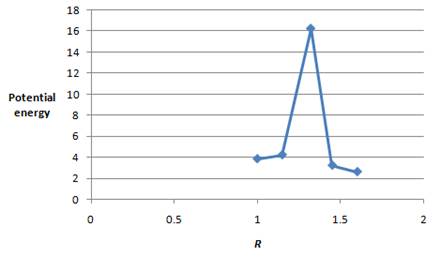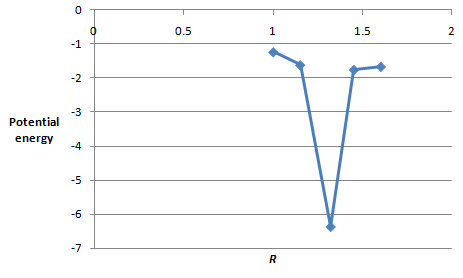
Concept explainers
Interpretation:
The value of
Concept introduction:
The wavefunction contains all the information about the state of the system. The wavefunction is the function of the coordinates of particles and time. The wavefunction
Answer to Problem 12.56E
The values of
The simple potential energy diagram for this system is shown in Figure 1 and Figure 2.
Explanation of Solution
The value of
Where,
•
•
The value of
Where,
•
The value of
The wavefunction
The value of
Substitute the value of
Thus, the value of
Substitute the value of
Thus, the value of
Substitute the value of
Thus, the value of
Substitute the value of
Thus, the wavefunction
The value of
Substitute the value of
Thus, the value of
Substitute the value of
Thus, the value of
Substitute the value of
Thus, the value of
Substitute the value of
Thus, the wavefunction
The value of
Substitute the value of
Thus, the value of
Substitute the value of
Thus, the value of
Substitute the value of
Thus, the value of
Substitute the value of
Thus, the wavefunction
The value of
Substitute the value of
Thus, the value of
Substitute the value of
Thus, the value of
Substitute the value of
Thus, the value of
Substitute the value of
Thus, the wavefunction
The values of potential energy and
| Energy |
|
The plot between the potential energy with

Figure 1
The values of potential energy and
| Energy |
|
The plot between the potential energy with

Figure 2
The values of
The simple potential energy diagram for this system is shown in Figure 1 and Figure 2.
Want to see more full solutions like this?
Chapter 12 Solutions
Physical Chemistry
- Synthesize N-Methylcyclohexylamine from cyclohexanol using the necessary organic or inorganic reagents. Draw the structures of the compounds.arrow_forwardSynthesize N-Methylcyclohexylamine from cyclohexanol using the necessary organic or inorganic reagents. Draw the structures of the compounds.arrow_forwardIf possible, please provide the formula of the compound 3,3-dimethylbut-2-enal.arrow_forward
- Synthesize 1,4-dibromobenzene from acetanilide (N-phenylacetamide) using the necessary organic or inorganic reagents. Draw the structures of the compounds.arrow_forwardIndicate the products obtained by mixing (3-oxo-3-phenylpropyl)triphenylphosphonium bromide with sodium hydride.arrow_forwardWe mix N-ethyl-2-hexanamine with excess methyl iodide and followed by heating with aqueous Ag2O. Indicate the major products obtained.arrow_forward
- Indicate the products obtained by mixing acetophenone with iodine and NaOH.arrow_forwardIndicate the products obtained by mixing 2-Propanone and ethyllithium and performing a subsequent acid hydrolysis.arrow_forwardIndicate the products obtained if (E)-2-butenal and 3-oxo-butanenitrile are mixed with sodium ethoxide in ethanol.arrow_forward
- Question 3 (4 points), Draw a full arrow-pushing mechanism for the following reaction Please draw all structures clearly. Note that this intramolecular cyclization is analogous to the mechanism for halohydrin formation. COH Br + HBr Brarrow_forwardIndicate the products obtained if 2,2-dimethylpropanal and acetaldehyde are mixed with sodium ethoxide in ethanol.arrow_forwardIndicate the products obtained if 2,2-dimethylpropanal and acetaldehyde are reacted with sodium ethoxide in ethanol.arrow_forward
 Chemistry: The Molecular ScienceChemistryISBN:9781285199047Author:John W. Moore, Conrad L. StanitskiPublisher:Cengage Learning
Chemistry: The Molecular ScienceChemistryISBN:9781285199047Author:John W. Moore, Conrad L. StanitskiPublisher:Cengage Learning
